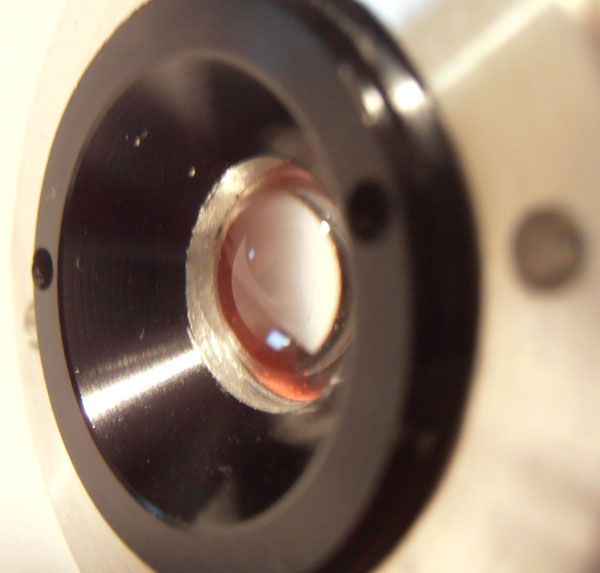did you look at the edmunds optics white paper? if only out of curiosity? On “page 1” (part 1) they go over, basically, our entire basic site strategy. Which is one lens. They describe the LED source in terms of theta half angles, and the lens in terms of “NA” which is numerical aperture.
in terms of a camera, “aperture” makes sense to me. the numerical aperture of the beam, in this site wide strategy,is basically the sine of the half angle of the LED emission. They use an example of the LED with a plus/minus 50 degrees emission of half intensity. sounds fairly representative to me.
you get NAbeam = sin(100/2) = sin (50) = .77
I mean, THATS not hard, the sine of the half angle of the LED emission? is the “numerical aperture”. Any fool (like me?) with a TI-30 or the budget equivalent, can play along at home. If what you wan to illuminate is close enough to that beam? you dont need a LENS, but, we want to go further than a few inches.
you get a lens, which should sound familiar to any zoomie enthusiast. First, you want the NA of the lens to be greater or equal to the NA of the LED emission. the theta angle stated in radians, is the diameter of the source divided by the focal length of the lens.
namely, Theta prime(radians) = Ds / FL.
sounds a lot more complicated than it really is, radians convert directly to regular angles directly. Now, if you have born this out THUS far, they state at that point:
“This identity shows that a small beam
divergence may be achieved by either
reducing the source size or by increasing
the focal length of the collimating lens.”
and REALLY all they have done up to now? is state mathematically things we all already talk about. We already KNOW we would like a small sized LED, and we want the emission angle to be as small as we like. The xpg series being a “thrower”? Is simply described mathematically. We still havent moved off of anything we all dont already know, and that we all already talk about. The math hasnt gotten bad. Anyone awake in high school angebra and trig is still alive.
we cant GET a better LED yet, so, we increase the focal length of the lens. Gradeschool BLf, this is what we explicitly “do”.
They immediately state:
“As
the beam divergence of the light source
is reduced, the collimated beam diameter
increases proportionately. The collimated
beam diameter (Dc) right after the collimat-
ing lens can be estimated as follows:”
Dc = 2 * NAbeam * Fcol
which instead of us standing around and saying “wow! cool pencil beam!” or “hey, nice even flood!” ?? they mathematically state the diameter of the light beam. the number two, times the numerical aperture of the led, times the focal length of the lens? yields the beam diameter.
I can multiply on a calculator, i dont feel left out in the cold yet.
okay, so heres the “money shot”… they state our entire problem, still on page one/part one? as thus:
“As the focal length
of the lens is
increased while the
lens diameter stays
constant, there is a
tradeoff between
maximizing light
throughput and
minimizing beam
divergence”
THERE, in the middle of “page 1, part 1” our entire site strategy? and indeed,the entire site strategy of my night vision site? (IR zoomies, same thing) is summed up with MATH. you want better results? Theres a tradeoff, and we all know it. Hey, i’m a “redneck”, I l-i-k-e a “bigger hammer” theory, lol.
I have no problem with putting more amps thru the LED and doing better heatsinking. Its a bigger hammer. I like using the xpg or the best led, its a better hammer. I understand that using a larger diameter lens is a bigger hammer, and the redneck in me “groks” this perfectly. But, the paradox here is stated mathematically.
NOW, at this point? my night vision site? had us “fanning out” and infiltrating the flashlight sites, lol. We were running into the same “wall” as you guys here. longer focal length, wider lens… and you run into whats practical, and you run into the paradox.
==
in summation? the math hasnt gotten crazy. nothing beyond a few key presses on a TI-30. No gigantic equations. Youre doing ray traces, i assume YOU are still with me, right? The only thing i LIKE here? couple of things…
the entire “problem” is stated mathematically. No hunches, no “its all about the throw, dude” talk. They DO STATE your “diameter = throw” argument? They state it in a way that means something concrete.
Now, i know what you will say. “big deal, same problem we have, stated a different way” which is true, but This is page one, part one. They dont get off of PAGE ONE of the engineering paper? without the next best strategy…
i swear to GOD himself, theres no worse math than what we encountered here. Real simple. They tell us, the very next step. Will you permit me this indulgence? its just the next paragraph or two, and its easy to follow intructions and an equation no harder than what we saw here. easy.








